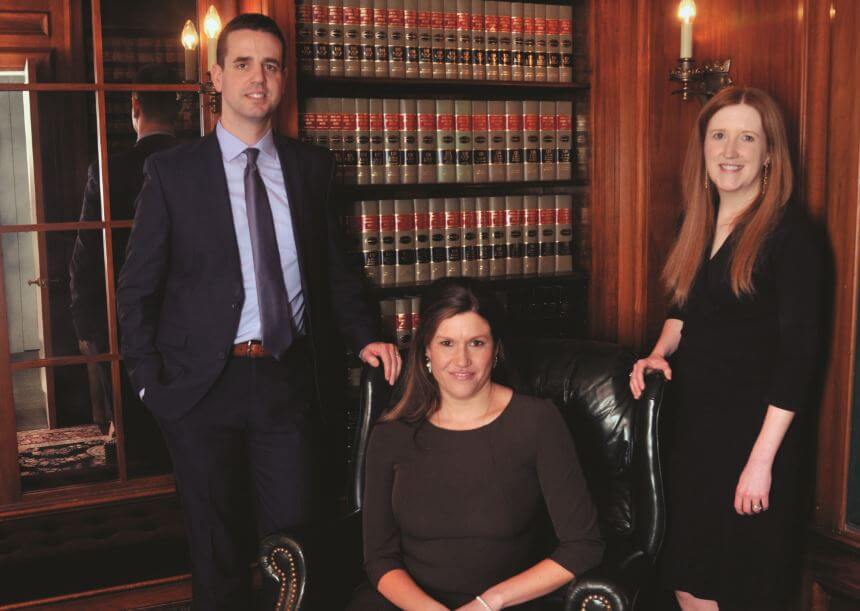Recognized by U.S. News & World Report as one of the 2018 Best Law Firms, Foley & Mansfield continues a nearly 30-year year tradition of providing legal expertise, creative solutions and extensive trial experience across jurisdictions from coast to coast. The firm’s top transactional and litigation attorneys deliver unparalleled representation in an array of practice areas, utilizing the industry’s leading technologies to enhance efficiency and client service. With a strong culture of diversity and inclusion, Foley & Mansfield recruits and retains the nation’s finest legal talent, including a contingent of accomplished next generation attorneys.
Meet Elizabeth Sorenson Brotten, Jason T. Mohr and Joanna M. Salmen, all partners practicing in the firm’s Minneapolis office. Each has been granted early and meaningful opportunities to grow in the law through taking on lead roles in depositions, motions and trial practice. These young lawyers are now among the new guard practicing in national asbestos defense litigation, a unique and evolving area of law that requires creative thinking and bold action.
Brotten is a native North Dakotan and graduate of William Mitchell College of Law. After clerking for the Minnesota Court of Appeals, she joined Foley & Mans field and earned her place as a firm partner for her outstanding work in mass tort and product liability defense. She recently returned to the firm after a stint at a smaller civil litigation firm, and today her practice includes serving as both trial counsel and national coordinating counsel in defense of asbestos claims. Brotten is a leader in the law, serving in state and national defense organizations, and contributing to social justice and humanitarian causes.
Mohr also hails from North Dakota. He earned his law degree at the University of North Dakota and worked as a federal law clerk to U.S. District Court Chief Judge Daniel L. Hovland before joining Foley & Mansfield. He made his mark practicing in asbestos defense litigation, and Mohr also exerts his expertise as national coordinating counsel in defense of asbestos claims.
Salmen grew up in St. Paul and, after earning her law degree at University of St. Thomas Law School, spent a year clerking at the Minnesota Court of Appeals. She then joined Foley & Mansfield, where she quickly proved herself an adept commercial and mass tort litigator. Salmen became a firm partner in 2017, and like her peers, her practice now centers primarily on asbestos defense litigation and coordinating counsel in defense of asbestos claims.
Mohr says that asbestos litigation is a unique area of practice for young attorneys, in part, because they are resolving issues around a material that has largely been out of use during their lifetimes. As such, this “new guard” is taking a fresh approach to old and ever-expanding issues.
“I generally go to depositions with folks who have been doing this work for a long time,” he says. “There is an obvious age gap in the asbestos world between the original attorneys who were there when the litigation started growing in the ’80s, and the next generation of asbestos attorneys. At our firm, some of the partners who have been doing this work since the beginning are approaching retirement. They are trusting us to pick up where they left off, and run with it.”
According to Brotten, one reason young lawyers are succeeding in this complex, highstakes arena is that they are “good at asking questions. We tend to question the way things were done in the past. That is the key to the future of asbestos litigation. We can’t keep doing things the way it was done even five years ago. More cases are being tried, the medical and factual issues are unique and evolving, and the new, higher-stakes climate requires original, outside-the-box thinking.”
This still robust area of litigation is continuing to evolve. “This is not cookie-cutter litigation, where you can reuse old motions and defenses,” Salmen explains. “You have to keep current to be effective, and we’re doing things now that attorneys weren’t doing when this litigation first started. Recently, a lot of cases are coming up where the allegations are that asbestos was brought home on the clothes of a worker and caused a family member to become ill. These cases weren’t brought previously.”
There is often a long gap between asbestos exposure and the development of disease, so many of the cases being litigated today stem from suspected toxic exposure that occurred in the ’60s and ’70s. But there are other new asbestos-related cases coming to light.
“We’re handling relatively new litigation arising out of exposure to commercial and cosmetic talc products that allegedly contain asbestos,” Brotten says. “This is definitely not our fathers’ litigation anymore. We have to be adaptive, and it’s exciting to be at this firm where we are encouraged to think creatively about cases and have the resources to do so.”
As one of the nation’s leading firms in asbestos defense litigation, Foley & Mansfield is uniquely equipped to not only provide its clients with an effective defense, but also to act as coordinating counsel for defense litigation nationally. This role involves managing client needs across the country, crafting defense strategies and directing local firms who are running cases in various jurisdictions. The watchword is consistency.
“Certain clients entrust our firm with the duty of coordinating their cases all over the country,” Mohr says. “We act as the go-between for local counsel in the various jurisdictions and our clients and their insurance carriers. The client doesn’t necessarily have the time or the inclination to correspond with every local counsel across the country. Coordinating counsel acts as an information hub and ensures consistency in the defense of the client. Our firm has been successful in this role, in part, because we have gathered a wealth of information since the genesis of this litigation, which is critical in the defense of asbestos cases. For example, plaintiffs are incentivized to point the finger at solvent defendants, even when the injury was caused by a company that filed bankruptcy as a result of asbestos liabilities. Our information allows us to identify those truly culpable companies, and defend our clients today.”
“It’s so important to control this type of litigation for a client,” Salmen says. “We like to get in on the ground level and develop a plan right away. We work with all kinds of clients, from sophisticated international organizations who have been doing this for decades and have a dedicated in-house team that we work with, to small local businesses who have never been sued in this litigation before, and we are guiding them on how to protect themselves from becoming a target and getting named in more cases. Each has unique needs that we work with to get the best possible outcome for them.”
While the geographic focus of the asbestos litigation team in Minneapolis extends from Minnesota and Wisconsin westward to the Dakotas and Montana, the nationwide scope of asbestos litigation and the national reach of Foley & Mansfield take these attorneys to other jurisdictions, as well. Developments in one jurisdiction may also impact the firm’s litigation elsewhere, so it is vital that Foley & Mansfield’s attorneys are constantly communicating and collaborating.
“There are other young people leading litigation in our other offices, too,” Brotten says. “One of our greatest strengths and resources is our people and how we work together. Any of us are willing to jump on a plane to help a partner with a trial, and if our team in California needs help, our Minnesota team will answer the call. We have each other’s backs, and that helps us better serve our clients.”
As the guard is changing in both firm leadership and command of asbestos defense litigation nationwide, Foley & Mansfield and its clients are in the best of hands. These attorneys of the next generation are innovative thinkers and business savvy individuals, who are using data to achieve better results, with greater accountability to clients. They are also caring professionals, who are using the law to serve justice and foster stronger communities from coast to coast.







